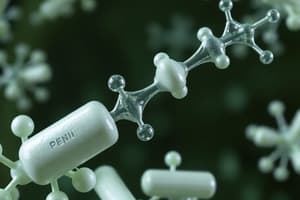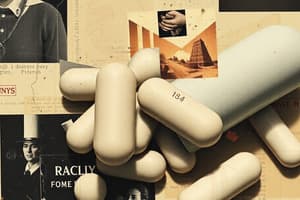Podcast
Questions and Answers
What is the primary mechanism of action of penicillin?
What is the primary mechanism of action of penicillin?
- Inhibiting protein synthesis in bacteria
- Inhibiting DNA replication in bacteria
- Destroying the bacterial cell wall (correct)
- Inhibiting RNA transcription in bacteria
What is the role of beta-lactamase inhibitors in combination with penicillins?
What is the role of beta-lactamase inhibitors in combination with penicillins?
- Inhibit the action of penicillin
- Stimulate bacterial growth
- Destroy beta-lactamase enzymes produced by bacteria (correct)
- Increase bacterial resistance to antibiotics
Which of the following medications is a combination of penicillin and a beta-lactamase inhibitor?
Which of the following medications is a combination of penicillin and a beta-lactamase inhibitor?
- Ticarcillin
- Ampicillin
- Amoxicillin
- Amoxicillin/clavulanic acid (Augmentin) (correct)
What is a potential side effect or complication associated with penicillin antibiotics?
What is a potential side effect or complication associated with penicillin antibiotics?
Why is it important to report persistent watery diarrhea to healthcare providers when taking penicillin antibiotics?
Why is it important to report persistent watery diarrhea to healthcare providers when taking penicillin antibiotics?
Flashcards
Penicillin Mechanism
Penicillin Mechanism
Disrupts bacterial cell wall synthesis, leading to cell lysis and death.
Beta-Lactamase Inhibitors
Beta-Lactamase Inhibitors
They block beta-lactamase, protecting penicillin from bacterial degradation.
Amoxicillin/Clavulanic Acid
Amoxicillin/Clavulanic Acid
A common medication that combines amoxicillin with clavulanic acid.
Penicillin Superinfections
Penicillin Superinfections
Signup and view all the flashcards
Diarrhea with Penicillin
Diarrhea with Penicillin
Signup and view all the flashcards
Study Notes
Penicillin Action
- Destroys bacterial cell wall by inhibiting production
- Effective against gram-positive and some gram-negative bacteria
Beta-Lactamase
- Enzyme produced by bacteria to inactivate or fight off antibiotics
Medications
- Examples of penicillin medications: Amoxicillin, Ampicillin, Penicillin, Penicillin V
- Penicillin and beta-lactamase inhibitors: Ampicillin/sulbactam (Unasyn), Amoxicillin/clavulanic acid (Augmentin), Ticarcillin/clavulanic acid (Timentin), and Piperacillin/tazobactam (Zosyn)
Side Effects and Complications
- Gastrointestinal effects: sore mouth, furry tongue
- Super-infections: C-diff, Pseudomembranous colitis (diarrhea), fungal infections (candidiasis)
- Hypersensitivity reactions: anaphylaxis
- Caution: liver failure, oral contraceptives
Nursing Interventions
- Report allergic reactions: rash, itchy throat, hives
- Report persistent watery diarrhea for Cloristidium difficile assessment
- Store oral liquids in refrigerated conditions
- Be aware of allergy to cephalosporins
Studying That Suits You
Use AI to generate personalized quizzes and flashcards to suit your learning preferences.




